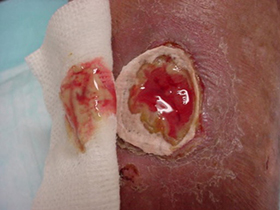
Paths to Practice Perfection
Meeting a Patient's Wound Care Needs at a Wound Care Center
Meeting a Patient's Wound Care Needs at a Wound Care Center

Introduction
Infected non-healing wounds can be difficult to treat. Negative Pressure Wound Therapy (NPWT) via the 3M™ ActiV.A.C.™ Therapy System can be used on these types of wounds in the home care setting. ActiV.A.C. Therapy System is a portable NPWT device for the mobile patient, with features that help maintain pressure at the wound site and detect leaks. In clinical practice, recalcitrant wounds often require a variety of different treatment modalities. It is common to step down from NPWT to an advanced wound dressing as part of the treatment plan. 3M™ Promogran Prisma™ Matrix has been found to be a cost-effective treatment for chronic wounds1. It is an advanced wound dressing composed of collagen and oxidized regenerated cellulose (ORC), with the added benefit of silver, a well-known antimicrobial agent. Promogran Prisma Matrix helps maintain a physiologically moist microenvironment at the wound surface that is conducive to granulation tissue formation, epithelialization, and rapid wound healing.
3M™ ActiV.A.C.™ Therapy System

3M™ Promogran Prisma™ Matrix

Case Study:
This is a single case presentation of an infected non-healing wound treated at the wound care center. NPWT utilizing the ActiV.A.C. Therapy System was initiated with home health care changing the dressings two times per week and once per week at the wound care center.
A 55-year-old male incurred an avulsion injury to his left anterior tibia when a motorcycle fell on his leg as he was walking it up a truck ramp. He initially tried to treat his wound at home for 2 days with no success and so went to the emergency department. His wound was cleaned up, cultured and he was referred to the wound care center. The Wound Care Center found the wound was MRSA positive and IV antibiotic treatment was initiated along with a comprehensive wound care solution starting with NPWT).
Co-morbidities:
- Steroid dependent asthmatic
- Hypertension
- Obesity
Wound Progression

Initial measurements 4.5 cm x 5.0 cm x 1.0 cm.

After three weeks of NPWT the wound was reduced to 3.5 cm x 4.0 cm x 0.5 cm with robust granulation tissue present.

The patient presented with some blistering in the periwound area, so the ActiV.A.C. Therapy System was discontinued, and Promogran Prisma Matrix covered with a gauze dressing to be changed every three days was initiated.

The wound showed continued improvement with Promogran Prisma Matrix, so NPWT was not reinitiated.

After one week of Promogran Prisma Matrix the wound measured 2.4 cm x 3.0 cm x 0.2 cm and so this treatment plan was continued.

Four weeks later, the wound size had continued to decrease.

Six weeks later wound was essentially closed.
Treatment Modalities
- 3M™ ActiV.A.C.™ Therapy System
- 3M™ Promogran Prisma™ Matrix
Conclusion:
The wound was completely epithelialized after 9 weeks of care at the wound care center. The application of the ActiV.A.C. Therapy System followed by ORC/Collagen with silver dressing was an effective treatment for this infected non-healing wound.
Do you have questions regarding this case study?
Connect with a 3M Account Representative to learn more.
Patient data and photos courtesy of Dot Weir CWS, RN, WOCNB.
Note: Dot Weir is a paid consultant for 3M products.
As with any case study, the results and outcomes should not be interpreted as a guarantee or warranty of similar results. Individual results may vary depending on the patient’s circumstances and condition.
NOTE: Specific indications, contraindications, warnings, precautions, and safety information exist for these products and therapies. Please consult a clinician and production instructions for use prior to application. Rx only.
© 2021 3M. All rights reserved. 3M and the other marks shown are marks and/or registered marks. Unauthorized use prohibited. PRA-PM-US-03257 (07/21).
References
- Nisi G, Brandi C, Grimaldi L, Calabró, D’Aniello C. Use of a protease-modulating matrix in the treatment of pressure sores. Chir Ital. Jul-Aug 2005;57(4):465-468.


Comments
There are 0 comments for this article